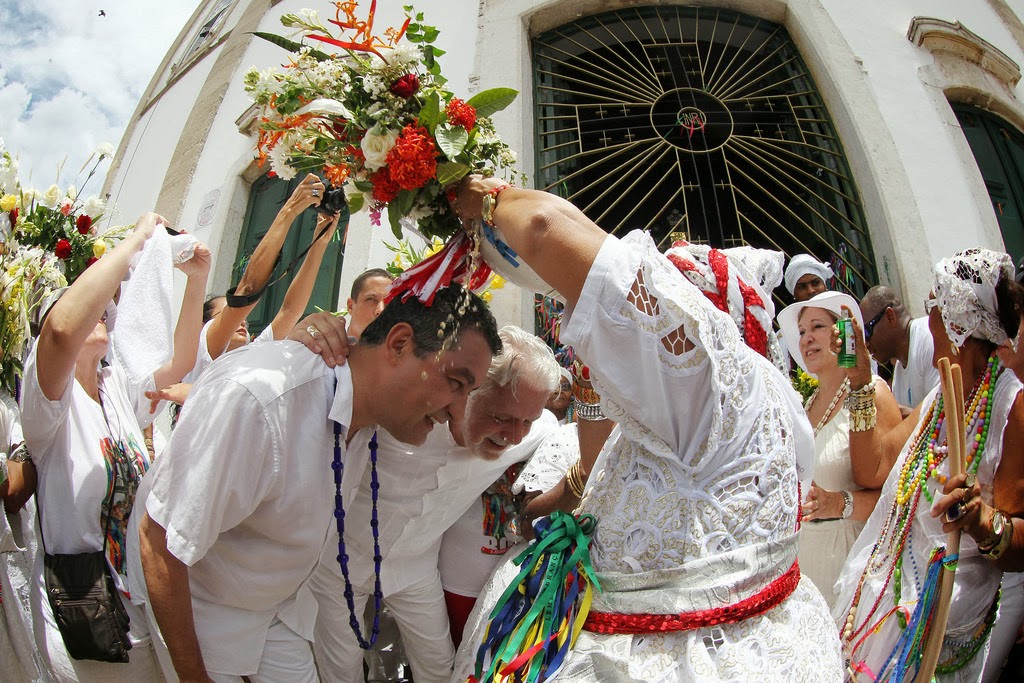The best time to visit the Brazilian city of Salvador, the capital of Bahia, is in the summertime, between the months of December and March. At this time the city is on fire with religious, folk, and popular festivals all filled with music, food, drinks, água de cheiro (perfumed water), flowers, dancing and happiness. Almost every weekend in this time frame there is either a lavagem (ritual washing of a church which culminates into a party) or a Candomblé `beating of the drums' (a ceremony in the Nigerian Yoruba religion of Candomblé). The three most popular festivals are: the Lavagem of the Church of Nosso Senhor do Bonfim, the Festa of Yemanjá (Yoruban Goddess of the Ocean) and of course, Carnaval. (Pravina Shukla)
Bonfim Festival (Lavagem do Bonfim) is one of the biggest events in Salvador. The Catholic celebration starts at Nossa Senhora da Conceição Church, with devotees wearing white clothing, beads and carrying the important vases containing perfumed water along with beautiful flowers before heading to Nosso Senhor do Bonfim Church, which is the best known in Bahia State and an important symbol for locals. The festival honors Senhor do Bonfim (associated with the important orixá Oxalá, by Candomblé - Nigerian Yoruba religion - whose color is white).
 |
| Baianas. Their costumes were and are used in public celebrations of Candomblé. Long skirts, gowns, Ojás and pano-da-costa well starched and very white honoring Oxalá and the Lord of Bonfim, they carry flowers with the stems immersed in perfumed water to purify the participants of the party . They call it Oxalá's water. |

The annual and popular Lavagem do Bonfim festival is attended by thousands of people who come to not only take part in the ritual blessing but to also join in the celebrations afterwards.
The procession travels for about 10 miles to the Church of Bonfim where even more spectators are gathered, eagerly awaiting the blessing that takes place there. During the blessing, the perfumed water that has been so carefully carried is subsequently poured over people's hands and on their heads.
 |
| Governor of Bahia. Photo flickr by GOVBA |
The steps of the Church of Bonfim are also cleaned with the perfumed water as part of the ritual cleansing of the church. At this point, all sing the anthem of Senhor do Bonfim and it is after this event that the street parties often begin and contain plenty of music entertainment, singing and dancing not to mention plenty of street vendors to help keep everyone going. People go to the booths by the Church of Bonfim to eat and drink. There's dancing on the streets, among the traditional booths of Baianas selling acarajé (West African food made of black eyed peas fried in palm oil).
 |
| Inside of the Bonfim Church. Photo flickr by FotosGOVBA |
 |
| Acarajé. Photo flickr by Yvone |
One popular tradition is to have a Bonfim ribbon tied around your wrist and to make a wish, if the ribbon wears off naturally then it is believed that your wish will come true.
 |
| Bonfim ribbons |
This festival takes place usually the second Thursday of January every year. This ritual has been occurring in Salvador since 1754.
There are also horse-drawn carriages, musicians, as well as government officials, including the mayor of Salvador. The Carnaval group Filhos de Gandhy (Son of Gandhi), who traditionally lead the procession, march right behind the Baianas all the way to the Church of Bonfim.
 |
| Filhos de Ghandi |
The eight-kilometer procession is full of energy, drumming, chanting. The sun is piercing hot, the people stay cool by drinking water, beer, orange juice, or by pouring little bags of water over their heads.























No comments:
Post a Comment